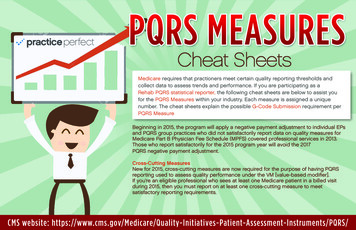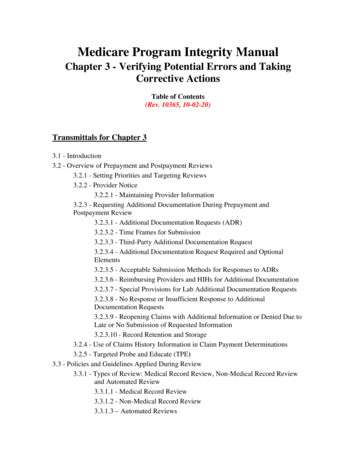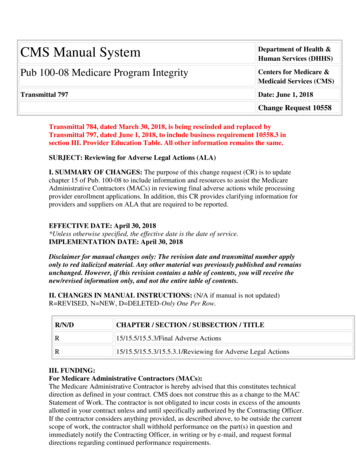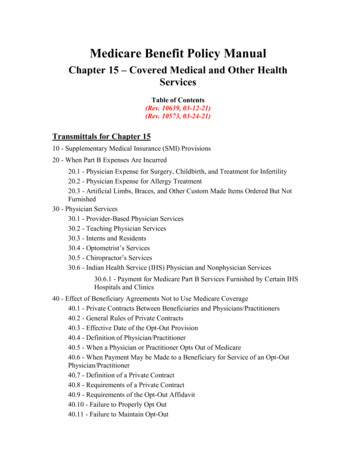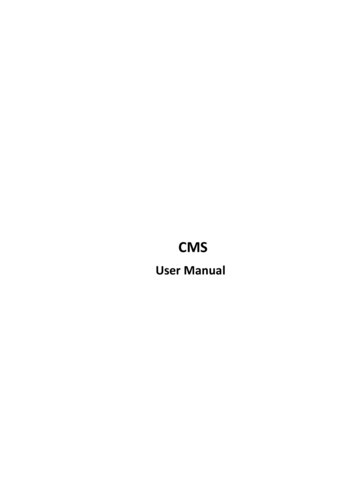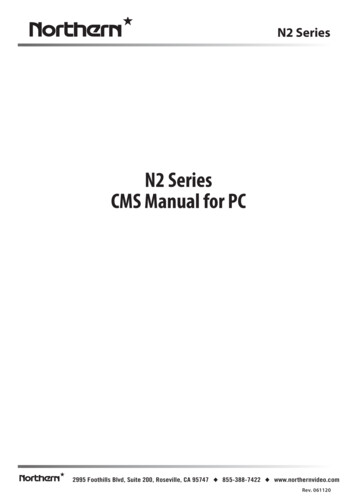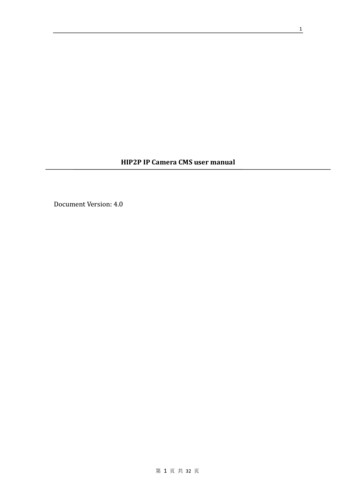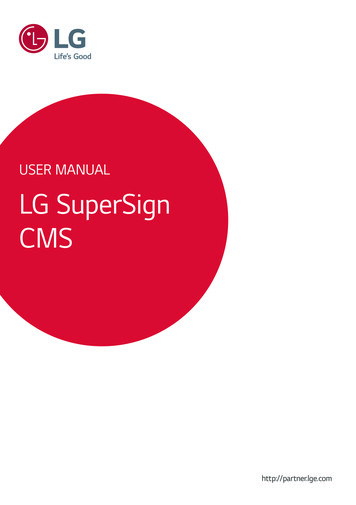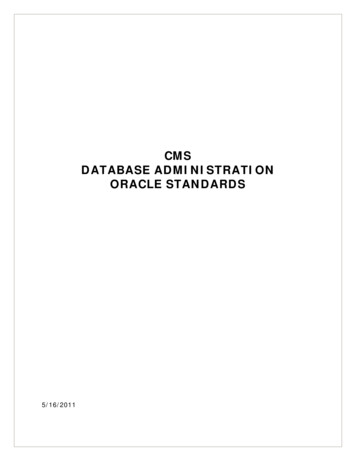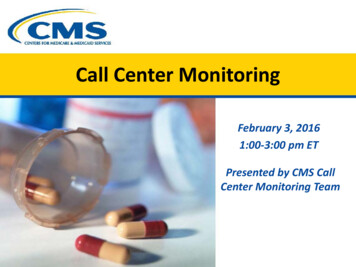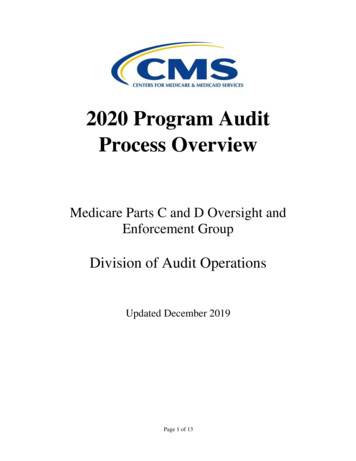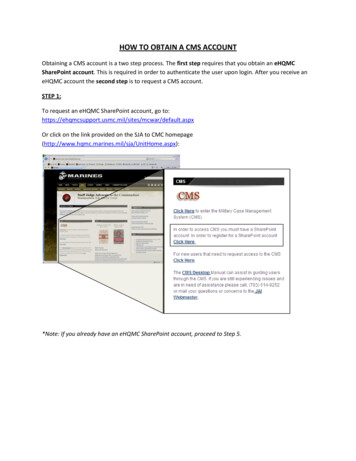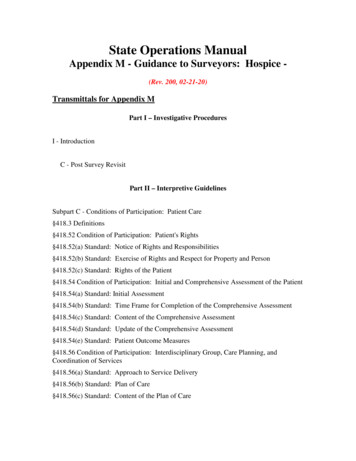
Transcription
State Operations ManualAppendix M - Guidance to Surveyors: Hospice (Rev. 200, 02-21-20)Transmittals for Appendix MPart I – Investigative ProceduresI - IntroductionC - Post Survey RevisitPart II – Interpretive GuidelinesSubpart C - Conditions of Participation: Patient Care§418.3 Definitions§418.52 Condition of Participation: Patient's Rights§418.52(a) Standard: Notice of Rights and Responsibilities§418.52(b) Standard: Exercise of Rights and Respect for Property and Person§418.52(c) Standard: Rights of the Patient§418.54 Condition of Participation: Initial and Comprehensive Assessment of the Patient§418.54(a) Standard: Initial Assessment§418.54(b) Standard: Time Frame for Completion of the Comprehensive Assessment§418.54(c) Standard: Content of the Comprehensive Assessment§418.54(d) Standard: Update of the Comprehensive Assessment§418.54(e) Standard: Patient Outcome Measures§418.56 Condition of Participation: Interdisciplinary Group, Care Planning, andCoordination of Services§418.56(a) Standard: Approach to Service Delivery§418.56(b) Standard: Plan of Care§418.56(c) Standard: Content of the Plan of Care
§418.56(d) Standard: Review of the Plan of Care§418.56(e) Standard: Coordination of Services§418.58 Condition of Participation: Quality Assessment and Performance Improvement§418.58(a) Standard: Program Scope§418.58(b) Standard: Program Data§418.58(c) Standard: Program Activities§418.58(d) Standard: Performance Improvement Projects§418.58(e) Standard: Executive Responsibilities§418.60 Condition of Participation: Infection Control§418.60(a) Standard: Prevention§418.60(b)Standard: Control§418.60(c) Standard: Education§418.62 Condition of Participation: Licensed Professional Services§418.64 Condition of Participation: Core Services§418.64(a) Standard: Physician Services§418.64(b) Standard: Nursing Services§418.64(c) Standard: Medical Social Services§418.64(d) Standard: Counseling Services§418.66 Condition of Participation: Nursing Services Waiver Of Requirement ThatSubstantially All Nursing Services Be Routinely Provided Directly by a Hospice§418.70 Condition of Participation: Furnishing of Non-core Services§418.72 Condition of Participation: Physical Therapy (PT), Occupational Therapy (OT),and Speech-Language Pathology (SLP)§418.74 Waiver of Requirement-Physical Therapy, Occupational Therapy, Speechlanguage Pathology and Dietary Counseling§418.76 Condition of Participation: Hospice Aide and Homemaker Services§418.76(a) Standard: Hospice Aide Qualifications§418.76(b) Standard: Content and Duration of Hospice Aide Classroom and SupervisedPractical Training§418.76(c) Standard: Competency Evaluation§418.76(d) Standard: In-service Training§418.76(e) Standard: Qualifications for Instructors Conducting Classroom AndSupervised Practical Training
§418.76(f) Standard: Eligible Competency Evaluation Organizations§418.76(g) Standard: Hospice Aide Assignments and Duties§418.76(h) Standard: Supervision of Hospice Aides§418.76(i) Standard: Individuals Furnishing Medicaid Personal Care Aide-OnlyServices under a Medicaid Personal Care Benefit§418.76(j) Standard: Homemaker Qualifications§418.76(k) Standard: Homemaker Supervision and Duties§418.78 Condition of participation: Volunteers§418.78(a) Standard: Training§418.78(b) Standard: Role§418.78(c) Standard: Recruiting and Retaining§418.78(d) Standard: Cost Saving§418.78(e) Standard: Level of ActivitySubpart D --Conditions of Participation: Organizational Environment§418.100 Condition of Participation: Organization and Administration of Services§418.100(a) Standard: Serving the Hospice Patient and Family§418.100(b) Standard: Governing Body and Administrator§418.100(c) Standard: Services§418.100(d) Standard: Continuation of Care§418.100(e) Standard: Professional Management Responsibility§418.100(f) Standard: Hospice Multiple Locations§418.100(g) Standard: Training§418.102 Condition of Participation: Medical Director.§418.102(a) Standard: Medical Director Contract§418.102(b)Standard: Initial Certification of Terminal Illness§418.102(c) Standard: Recertification of the Terminal Illness§418.102(d) Standard: Medical Director Responsibility§418.104 Condition of participation: Clinical Records§418.104(a) Standard: Content§418.104(b) Standard: Authentication§418.104(c) Standard: Protection of Information§418.104(d) Standard: Retention of Records
§418.104(e) Standard: Discharge or Transfer of Care§418.104(f) Standard: Retrieval of Clinical Records§418.106 Condition of Participation: Drugs and Biologicals, Medical Supplies, andDurable Medical Equipment§418.106(a) Standard: Managing Drugs and Biologicals§418.106(b) Standard: Ordering of Drugs§418.106(c) Standard: Dispensing of Drugs and Biologicals§418.106(d) Standard: Administration of Drugs and Biologicals§418.106(e) Standard: Labeling, Disposing, and Storing of Drugs and Biologicals§418.106(f) Standard: Use and Maintenance of Equipment and Supplies§418.108 Condition of Participation: Short-term Inpatient Care§418.108(a) Standard: Inpatient Care for Symptom Management and Pain Control§418.108(b) Standard: Inpatient Care for Respite Purposes§418.108(c)Standard: Inpatient Care Provided under Arrangements§418.108(d) Standard: Inpatient Care Limitation§418.108(e) Standard: Exemption from Limitation.§418.110 Condition of Participation: Hospices that Provide Inpatient Care Directly§418.110(a) Standard: Staffing§418.110(b) Standard: Twenty-four Hour Nursing Services§418.110(c) Standard: Physical Environment§418.110(d) Standard: Fire Protection§418.110(e) Standard: Patient Areas§418.110(f) Standard: Patient Rooms§418.110(g) Standard: Toilet/Bathing Facilities§418.110(h) Standard: Plumbing Facilities§418.110(i) Standard: Infection Control§418.110(j) Standard: Sanitary Environment§418.110(k) Standard: Linen§418.110(l) Standard: Meal Service and Menu Planning§418.110(m) Standard: Restraint or Seclusion§418.110(n) Standard: Restraint or Seclusion Staff Training Requirements§418.110(o) Standard: Death Reporting Requirements
§418.112 Condition of Participation: Hospices that Provide Hospice Care to Residents ofa SNF/NF or ICF/IID§418.112(a) Standard: Resident Eligibility, Election, and Duration of Benefits§418.112(b) Standard: Professional Management§418.112(c) Standard: Written Agreement§418.112(d) Standard: Hospice Plan of Care§418.112(e) Standard: Coordination of Services§418.112(f) Standard: Orientation and Training of Staff§418.114 Condition of Participation: Personnel Qualifications§418.114(a) Standard: General Qualification Requirements§418.114(b) Standard: Personnel Qualifications for Certain Disciplines§418.114(c) Standard: Personnel Qualifications When No State Licensing, Certificationor Registration Requirements Exist§418.114(d) Standard: Criminal Background Checks§418.116 Condition of Participation: Compliance with Federal, State, and Local Lawsand Regulations Related to the Health and Safety of Patients§418.116(a) Standard: Multiple Locations§418.116(b) Standard: Laboratory Services
Part I – Investigative ProceduresI – IntroductionSurvey protocols and Interpretive Guidelines are established to provide guidance topersonnel conducting surveys of hospices. They serve to clarify and/or explain the intentof the regulations. All surveyors are required to use them in assessing compliance withFederal requirements. The purpose of the protocols and guidelines is to direct thesurveyor’s attention to avenues of investigation in preparation for the survey, conductingthe survey, and evaluating the survey findings.These protocols represent the view of the Centers for Medicare & Medicaid Services(CMS) on relevant areas and items that must be inspected/reviewed under eachregulation. The use of these protocols promotes consistency in the survey process. Theprotocols assure that a facility’s compliance with the regulations is reviewed in athorough, efficient, and consistent manner so that at the completion of the survey,surveyors have sufficient information to make compliance decisions.Although surveyors use the information contained in the Interpretive Guidelines in theprocess of making a determination about a hospice’s compliance with the regulations,these guidelines are not binding. Interpretive Guidelines do not establish requirementsthat must be met by hospices, do not replace or supersede the law or regulations, and maynot be used alone as the sole basis for a citation. All mandatory requirements forhospices are set forth in relevant provisions of the Social Security Act and in regulations.The Interpretive Guidelines do however, contain authoritative interpretations andclarification of statutory and regulatory requirements and are used to assist surveyors inmaking determinations about a hospice’s compliance.Survey TeamThe State survey agency (SA), or the CMS Regional Office (RO) for Federal teams,decides the size of the team. Each hospice survey team should include at least one RNwith hospice survey experience. Other surveyors who have the expertise to determinewhether the hospice is in compliance may be used as needed.Training for Hospice SurveyorsHospice surveyors should have the necessary training and experience to conduct ahospice survey. All hospice surveyors must attend a CMS sponsored Basic HospiceSurveyor Training Course. New surveyors may accompany the team as part of theirtraining prior to completing the CMS Basic Hospice Surveyor Training Course.
Types of Hospice SurveysA - Initial CertificationPrior to the initial Medicare certification survey, a prospective hospice should notify theRO and/or the SA that it wants to apply for Medicare certification. The prospectivehospice must complete a Medicare enrollment application (Form CMS 855A). This formcan be found l/02 EnrollmentApplications.asp#TopOfPage. The assigned Medicare Administrative Contractor (MAC) will review theapplication, verify the information and notify the RO and SA of their enrollmentrecommendation. Additional information on this process is available in §2005A.Initial Medicare Certification SurveyBefore the SA or the National Accrediting Organization (AO) with deeming authorityconducts the initial Medicare certification survey, the SA must have received writtendocumentation submitted by the prospective hospice requesting an initial certificationsurvey. At the time of the survey, the prospective hospice must: Be operational; Have completed the Medicare Enrollment Application Form CMS-855A and hadthis form verified by the assigned MAC; Have provided care to a minimum of 5 hospice patients (not required to beMedicare patients.) At least 3 hospice patients should be receiving care at the time of the initialMedicare certification survey. If the hospice is located in a medically underservedarea, as determined by the CMS RO, the CMS RO may reduce the minimumnumber of patients from 5 to 2. At least 1 of the 2 required patients should bereceiving care from the hospice at the time of the initial Medicare survey; Be providing all services needed by the patients actually being served; and Be capable of demonstrating the operational capability of all facets of itsoperations.In the event that the hospice patients being served at the time of the survey do not requirethe full scope of hospice services, verify that the hospice is fully prepared to provide allservices necessary to meet the hospice CoPs.
It is not necessary to inspect the facility where the inpatient services will be providedunder arrangement or in space share with a Medicare certified facility. The contract forthe inpatient services must be reviewed to ensure that it is valid and there is no doubt thatthe hospice will be able to provide the service when needed.The effective date of Medicare participation can be no earlier than the date the hospice isprepared to provide all of the required services and meets all hospice CoPs. In no casecan the effective date be earlier than the date the hospice meets all the Federalrequirements (42 CFR 489.13).All initial hospice surveys are unannounced and must verify compliance with all theregulatory requirements contained in §418.52 thru §418.116. (See §2700A)B - Recertification Survey of Participating HospicesAll recertification hospice surveys are unannounced and must verify compliance with allthe regulatory requirements contained at §418.52thru §418.116. If an existing certifiedhospice has a new inpatient unit or an inpatient unit that it wishes to relocate, verifycompliance with the regulations at §418.110.Routinely conduct the recertification survey at a multiple location of the hospice, ifapplicable, when that location serves more patients than the initial location issued theCMS certification number. Whenever possible, visit all locations of the hospice duringthe survey. Deficiencies found at any multiple location(s) are applicable to the entirehospice.C - Post-Survey RevisitIn some cases, the SA may verify correction of deficiencies through mail, telephone orelectronic contact in lieu of an on-site visit. However, an on-site visit is required for anycondition level deficiency. Through the on-site visit or other contact, assess the hospice’scorrection of the deficiencies previously cited on the Statement of Deficiencies and Planof Correction, Form CMS-2567.The purpose of the post-survey onsite revisit is to reevaluate the specific care and servicesthat were cited during the survey that cannot be adequately assessed by mail, telephone,or electronic contact. The nature of the deficiencies dictates the necessity for and scopeof the post-survey revisit. If deficiencies were originally identified during home visits,home visits may be necessary on the revisit. Conduct as many home visits as necessary toassess compliance. Assess the compliance of the hospice on all deficiencies cited on theForm CMS-2567. If a deficiency is subsequently corrected, the SA completes the PostCertification Revisit Report, Form CMS-2567B, as appropriate. (Refer to §2732B foradditional information.) If at the time of the post-survey revisit, some deficiencies havenot been corrected, or additional deficiencies are identified, the SA completes another
Form CMS-2567 summarizing the deficiencies by data prefix tag. The SA may examineall conditions, as needed, to determine compliance status. The hospice must provide aplan of correction including completion dates for deficiencies identified during a postsurvey revisit.D - Complaint InvestigationsInvestigation and resolution of complaints is a critical certification activity. Eachcomplaint against a hospice must be documented, investigated and resolved. Follow theguidance in Chapter 5 for investigations of complaints.If the hospice is found to have one or more condition-level deficiencies during thecomplaint investigation, all conditions must be reviewed. Follow the InterpretiveGuidelines contained in Part II of this Appendix.II – The Survey FocusThe hospice outcome-oriented survey process emphasizes the hospice’s performance andits effect on patients. The process first directs the surveyor to focus on the services beingprovided, and then to examine the structures and processes that contribute to the qualityof the services. The primary focus of the survey is on patient outcomes, the hospice’spractices in implementing the requirements, and provision of hospice services. The intentof the survey is to evaluate each of the CoPs in the most efficient manner possible. Thesurveyor considers the interrelatedness of the regulations while evaluating compliancethrough observations, interviews, home visits, and record reviews.III - The Survey TasksThe hospice survey process consists of completing the following tasks with an assessmentof the principal components listed below. Task 1 Pre-Survey Preparation; Task 2 Entrance Interview; Task 3 Information Gathering; Task 4 Information Analysis; Task 5 Exit Conference, and Task 6 Formation of the Statement of Deficiencies.
Task 1 – Pre-Survey PreparationPrior to each survey, review the hospice’s file in accordance with §2704. In addition,review the Interpretive Guidelines, which contain critical questions to ask during theentrance conference and throughout the survey.Task 2 - Entrance Interview(Rev. 104, Issued: 03-07-14, Effective: 03-07-14, Implementation: 03-07-14)The entrance interview sets the tone for the entire survey. The surveyor must establishrapport with the hospice staff. During this interview, gather information to understandhow the hospice organizes itself, and provides hospice care and services to patients.1.Upon arrival at the hospice, complete the following primary activities: Present identification and introduce any survey team members;Request a meeting with appropriate staff based on the organizationalcharacteristics of the hospice. Request a copy of the organizational chart;Inform the administrator or designee of the purpose of the survey;Ask the administrator or designee to explain the organization, services provided(directly and under arrangement) and the relationship to any corporate structure;Explain the survey process, and estimate the number of days onsite;Be aware that the unannounced survey may be disruptive to the normal dailyactivities of the hospice;Discuss the extent to which hospice staff may be involved during the survey;Set up the schedule for any necessary interviews with key staff (e.g., medicaldirector, spiritual or pastoral counselor, bereavement counselor, volunteersupervisor, social worker, RN coordinator, etc.);Request that the hospice complete the Form CMS-417, Hospice Request forCertification in the Medicare Program (Exhibit 72) and return it to you as soon aspossible, but no later than within 24 hours of the entrance conference, andRequest space to work.Investigate any discrepancies in information obtained during the entrance interviewthrough observation, interviews with key staff, and a review of source documents, asneeded, during the survey.2. Request the following information during the entrance interview: Verification of addresses of all locations and/or short term inpatient facilities usedby the hospice (either directly or under arrangements);
Access to clinical records and the equipment necessary to read any clinical recordsmaintained electronically. The hospice must also produce a paper copy of therecord, if requested by the surveyor;Information given to the patient on admission to hospice;Documentation of hospice aide training and/or competency evaluations and inservice training;Information concerning services not provided directly;Number of unduplicated admissions for the entire hospice during the recent 12month period, including Medicare/Medicaid and private pay patients;Number of current patients who are receiving hospice care at home, in aninpatient facility, SNF/NF, ICF/IID or other facility;List or access to names of patients scheduled for a home visit during the survey;Access to all active patient names (Medicare/Medicaid/private pay) receivinghospice services that identifies the election date, diagnosis, and date the initial andcomprehensive assessment was completed. This will aid in selecting the samplefor home visits and record reviews;Access to bereavement records for expired patients who received services duringthe last 12 months;List of current employees and volunteers, including name and title;List of contracts as applicable (e.g., SNF/NF, DME, Pharmacy, Inpatient facilities;Names of key staff (e.g., RN coordinator(s) for IDG(s), and persons mostknowledgeable about the hospice aides, homemakers, volunteers, infectioncontrol, quality assessment and performance improvement (QAPI), in-servicetraining, clinical supervision, bereavement);Clinical staff person who will be the primary resource responding to thesurveyor’s questions;Documentation of grievances/complaints that the hospice received during the past12 months;Personnel files, policies and procedures, and CLIA
§418.114(c) Standard: Personnel Qualifications When No State Licensing, Certification or Registration Requirements Exist §418.114(d) Standard: Criminal Background Checks §418.116 Condition of Participation: Compliance with Federal, State, and Local Laws and
